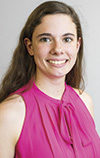Four Western veterinarians traveled to the Dominican Republic in November to help rural dairy producers improve milk production and milk quality.
The vets, who are all University of California – Davis graduates, left their practices for nine days to provide veterinary assistance and animal health training to farmers in the Sabana Larga region in the northwest part of the country. The trip was a partnership between Breath of Life International and Christian Veterinary Mission (CVM).
Breath of Life International – or Aliento de Vida (ADV) in Spanish – was started by two men who wanted to change a trend in their country: young talent leaving the countryside and looking to the city for jobs. Wanting to support the rural villages, they help students get a degree in an area of expertise that they can then use to help their hometowns. Not only does ADV help the rural communities by educating future leaders, it also helps the community through mission trips to the students’ hometowns. These trips involve school and church outreach, as well as service to the greater community, and have included medical teams and construction projects. This was the third trip where livestock veterinarians were asked to help.
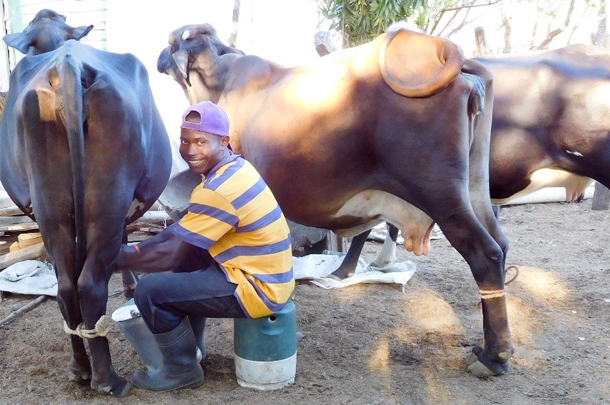
Dr. Bonnelyn Thwaits of Benson, Arizona, Dr. Richard Peyton of Visalia, California, and Drs. John and Laurie Day of Jerome, Idaho, have all been on mission trips previously with CVM. CVM focuses on using veterinary skills and knowledge to build relationships and transform lives. It encourages and empowers veterinarians and technicians to share the love of Christ through their local practice, as well as around the world on the short- and long-term mission trips.
Peyton reflected on his motivation to help the people of the Dominican Republic. “I feel that in the United States, we have been blessed. We have great education here. ... I think we’re supposed to share that, and it’s something that I’ve always wanted to do.”
This was Peyton’s third veterinary mission experience, having previously served with CVM in Nicaragua twice.
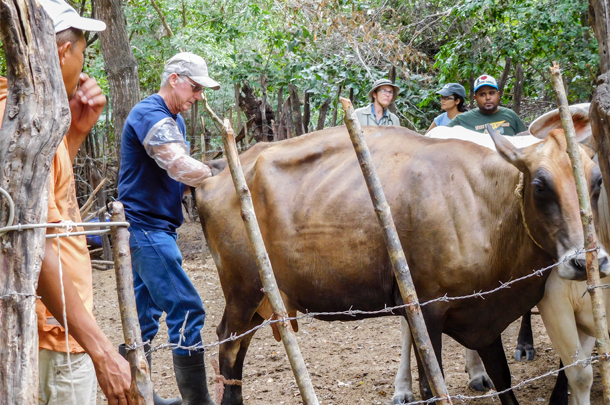
Peyton and John Day both work with large dairies doing reproductive exams and herd health consulting. Laurie Day runs a milk quality laboratory, and Thwaits has a bovine and equine reproduction practice, and works part-time as a small animal vet for the army. Their separate areas of expertise would be useful on this trip, but with some adjustment to the local production systems, which were a bit different from those on most U.S. dairies.
The dairymen in Sabana Larga use Holsteins and Holstein-Brahma crosses, mostly bred naturally. The Brahma genes add parasite and heat resistance. The cows are milked by hand twice a day, often using oxytocin to promote letdown. After milking into pails, they pour the product into milk cans. Buckets may or may not be rinsed, depending on whether there is water available; some “milking parlors” are a corral in the corner of a field. The milk cans are then transported on motorcycles, horse and cart, or trucks to a central receiving station with refrigerated bulk tanks. A tanker drives down miles of pot-holed dirt roads to pick up the milk from the central receiving station daily and delivers it to a cheese factory. After the milk cans are emptied, they are rinsed at the station, taken home and hung on a post to dry.
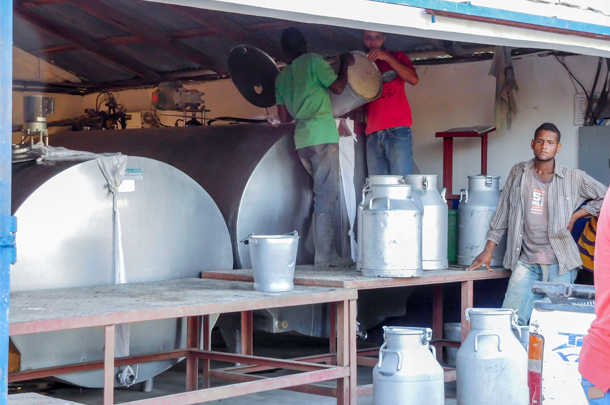
Due to a recent drought, there was limited feed for the livestock, and some days not even water available at the station to rinse the cans. This becomes an issue due to the fact that the money for the milk is divided evenly among all the producers based on bacteria count in the tanker truck.
The dairymen had been surveyed before the trip to assess their management and concerns. Milk quality and mastitis were primary concerns, as was la sequia or drought.
During the trip, the vets did pregnancy exams, took milk samples and checked injuries. Laurie Day worked in a makeshift lab, culturing milk to assess the causes of mastitis. While there was Strep. ag and Staph. aureus found in the milk shed, a majority of bacteria were likely from less-than-ideal sanitation of udders, hands and equipment. In the evenings, the veterinarians held seminars to educate the Dominicans on nutrition, physical exams and the dangers of overusing oxytocin, as well as mastitis control and the importance of cleanliness.
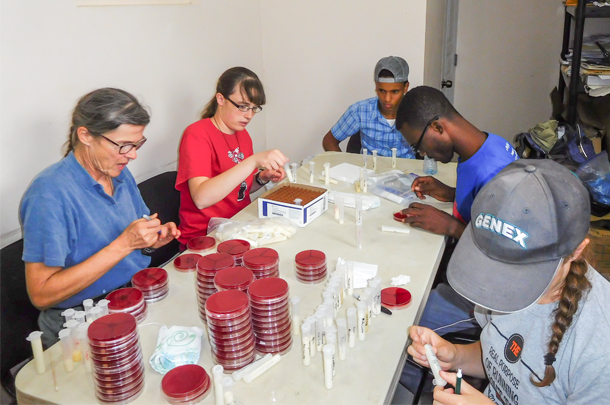
This trip was not only a chance to serve others, but to be blessed as well. Two of the veterinarians, Thwaits and Laurie Day, were roommates in vet school and had not seen each other in 21 years. “It was kind of interesting and surprising for both of us. Neither of us were very strong Christians or mission-minded while we were in college. I think it’s neat that God brought both of us to that place and allowed us to serve together. It was an added blessing for us,” Day says.
The nine days went by quickly. By the end of their stay, the veterinarians had been blessed by the Dominicans, and the dairymen hopefully were blessed by the Americans. At least some of the vets would like to return and work more with the Dominicans, whom they found to be very welcoming and eager to learn. All the vets plan on participating in other CVM trips in the future. One says, “It’s just one small way to honor God for everything he has given us.” PD
Annabelle Day is the reporter for the Jerome FFA Chapter in Jerome, Idaho.
PHOTO 1: Students, translators, local hosts and Americans (back row) gather outside the home they stayed at in Sabana Larga.
PHOTO 2: A local worker starts the afternoon milking the herd.
PHOTO 3: Dr. Richard Peyton does a pregnancy exam at one of the dairies as other team members look on.
PHOTO 4: Milk cans arrive at the receiving station and are emptied into bulk tanks. Volume is recorded for each producer, and milk is checked for acidity.
PHOTO 5: Missionaries and college students work together to culture milk samples in a makeshift lab. Photos provided by Jose Martinez, Laurie Day and Kathryne Day.
